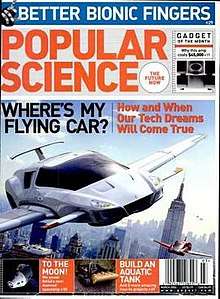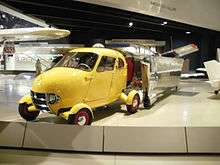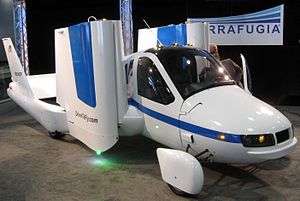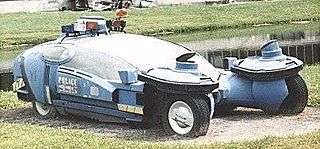Flying car
A flying car is a type of personal air vehicle or roadable aircraft that provides door-to-door transportation by both ground and air. The term "flying car" is also sometimes used to include hovercars.

Many prototypes have been built since the early 20th century, using a variety of flight technologies, such as distributed propulsion; some have true VTOL performance. The PAL-V Liberty roadable aircraft targeted 2021 to become the first flying car in full production.
Their appearance is often predicted by futurologists, with their failure ever to reach production leading to the catchphrase, "Where's my flying car?" Flying cars are also a popular theme in fantasy and science fiction stories.
History
Early developments
In 1926, Henry Ford displayed an experimental single-seat aeroplane that he called the "sky flivver". The project was abandoned two years later when a distance-record attempt flight crashed, killing the pilot.[1] The Flivver was not a flying car at all, but it did get press attention at the time, exciting the public that they would have a mass-produced affordable airplane product that would be made, marketed, sold, and maintained just like an automobile. The airplane was to be as commonplace in the future as the Model T of the time.
In 1940, Henry Ford famously predicted: "Mark my word: a combination airplane and motorcar is coming. You may smile, but it will come.”[1]
In 1942, the Soviet armed forces experimented with a gliding tank, the Antonov A-40, but it was not capable of flying on its own.

The Aerocar, designed and built by Molt Taylor, made a successful flight in December 1949, and in following years versions underwent a series of road and flying tests. Chuck Berry featured the concept in his 1956 song "You Can't Catch Me", and in December 1956 the Civil Aviation Authority approved the design for mass production, but despite wide publicity and an improved version produced in 1989, Taylor did not succeed in getting the flying car into production. In total, six Aerocars were built.[2]
In the period between 1956–1958, Ford's Advanced Design studio built the Volante Tri-Athodyne, a 3/8 scale concept car model. It was designed to have three ducted fans, each with their own motor, that would lift it off the ground and move it through the air. In public relation release, Ford noted that "the day where there will be an aero-car in every garage is still some time off", but added that "the Volante indicates one direction that the styling of such a vehicle would take".[3][4]
In 1957, Popular Mechanics reported that Hiller Helicopters was developing a ducted-fan aircraft that would be easier to fly than helicopters, and should cost a lot less. Hiller engineers expected that this type of an aircraft would become the basis for a whole family of special-purpose aircraft.[5]
In 1956, the US Army's Transportation Research Command began an investigation into "flying jeeps", ducted-fan-based aircraft that were envisioned to be smaller and easier to fly than helicopters. In 1957, Chrysler, Curtiss-Wright, and Piasecki were assigned contracts for building and delivery of prototypes. They all delivered their prototypes; however, Piasecki's VZ-8 was the most successful of the three. While it would normally operate close to the ground, it was capable of flying to several thousand feet, proving to be stable in flight. Nonetheless, the Army decided that the "Flying Jeep concept [was] unsuitable for the modern battlefield", and concentrated on the development of conventional helicopters. In addition to the army contract, Piasecki was developing the Sky Car, a modified version of its VZ-8 for civilian use..
In the mid-1980s, former Boeing engineer Fred Barker, founded Flight Innovations Inc. and began the development of the Sky Commuter, a small duct fans-based VTOL aircraft. It was a compact, 14-foot-long (4.3 m) two-passenger and was made primarily of composite materials.[6] In 2008, the remaining prototype was sold for £86k on eBay.[7]
Modern developments

As of 2017, several companies were developing electric flying cars, or eVTOLs, for production by 2020, including:
- Sky Drive by Cartivator — the start-up had announced its goal of a flight to ignite the 2020 Summer Olympics torch with its eVTOL,[8] postponed to due to the COVID-19 pandemic.[9] Toyota is a backer.[8]
- Kitty Hawk Flyer by Kitty Hawk Corporation — Larry Page's Zee.Aero and the Kitty Hawk Corporation (backed by Page) are developing flying cars.[10][11] In April 2017, Kitty Hawk unveiled its "Flyer" VTOL craft, which flies only over water.[12] Part of Kitty Hawk was split off into Cora by Wisk, a joint venture between Wisk Aero LLC and Boeing, in 2019.[13][8]
- Volocopter 2X by E-Volo, now Volocopter[8] — in August 2019, the Volocopter 2X was successfully tested at Helsinki airport for integrate with air traffic management services for unpiloted aerial craft AirMap, Altitude Angel and Unifly, a key element for commercial flight certification.[14]
- A³ Vahana by Airbus[8] — the Airbus eVTOL prototype made its first flight on May 3, 2019 in Donauwörth, Germany[15]
- EHang 216 by EHang[8] — the EHang 216 carried passengers in Changchun, China during a demonstration flight at the 2019 China-Northeast Asia Expo in late August 2019[16]
- Uber — the international ride-sharing company is working with Karem Aircraft[17] to develop the electric eCRM-003 eVTOL, with first tests expected by 2020, and very limited UberAir service trials by 2023 (Los Angeles, Dallas-Fort Worth, and Melbourne), with 50 vehicles serving five skyports per city.[18][19]
In 2016, AeroMobil was test-flying a prototype that obtained Slovak ultralight certification. When the final product will be available or how much it will cost is not yet specified.[20] In 2018, it unveiled a concept that resembled a flying sportscar with VTOL capability.[21]
Urban Aeronautics' X-Hawk[22] is a VTOL turbojet powered aircraft announced in 2006 with a first flight planned for 2009. It was intended to operate much like a tandem rotor helicopter, but with ducted fans rather than exposed rotors. The requisite decrease in rotor size would also decrease fuel efficiency. The X-Hawk was being promoted for rescue and utility functions. As of 2013, no flights had been reported.
Terrafugia have a flying road vehicle, the Terrafugia Transition On 7 May 2013, Terrafugia announced the TF-X, a plug-in hybrid tilt-rotor vehicle that would be the first fully autonomous flying car. It would have a range of 500 miles (800 km) per flight and batteries are rechargeable by the engine. Development of TF-X is expected to last 8–12 years, which means it will not come to market before 2019.
The Moller Skycar M400[23][24] is a prototype personal VTOL (vertical take-off and landing) aircraft which is powered by four pairs of in-tandem Wankel rotary engines, and is approaching the problems of satellite-navigation, incorporated in the proposed Small Aircraft Transportation System. Moller also advises that, currently, the Skycar would only be allowed to fly from airports & heliports. The Skycar M400 has tiny wheels and no road capability at all. Moller has been developing VTOL craft since the late 1960s, but no Moller vehicle has ever achieved free flight out of ground effect. The proposed Autovolantor model has an all-electric version powered by Altairnano batteries.[25]
The Xplorair PX200 was a French project of single-seater VTOL aircraft without rotating airfoil, relying on the Coandă effect and using an array of small jet engines called thermoreactors embedded within tiltwings' body. Announced in 2007, the project has been funded by the Government of France and was supported by various aerospace firms. A full-scale drone was scheduled for flight at Paris Air Show 2017, followed by the commercialization of a single seat flying car in the years after.
The SkyRider X2R is a prototype of a flying car developed by MACRO Industries, Inc. It is lighter than the Moller Skycar which has never successfully flown untethered.
The production-ready single-engine, roadable PAL-V Liberty autogyro, or gyrocopter, debuted at the Geneva Motor Show in March 2018, then became the first flying car in production, and was set to launch in 2020,[26] will full production scheduled for 2021 in Gujarat, India.[27]
Flying cars were planned to enter Russian market in 2018.[28]
Turkey's top UAV producer Baykar is focusing on working on its flying car named Cezeri. It was first introduced on TEKNOFEST Istanbul in 2019.
Design
A practical flying car must be capable of safe, reliable and environmentally-friendly operation both on public roads and in the air. For widespread adoption it must also be able to fly without a qualified pilot at the controls and come at affordable purchase and running costs.
Lift
Many types of aircraft technologies and form factors have been tried. The simplest and earliest approach was to give a driveable car added, bolt-on fixed flying surfaces and propeller. However, such a design must either tow its removable parts on a separate trailer behind it or return to its last landing point before taking off again. Other conventional takeoff fixed-wing designs include folding wings, which the car carries with it when driven on the road.
Vertical takeoff and landing (VTOL) designs include rotorcraft with folding blades, as well as ducted-fan and tiltrotor vehicles.[29] Most design concepts have inherent problems. Ducted-fan aircraft such as the Moller Skycar tend to easily lose stability and have been unable to travel at greater than 30–40 knots.[30] Tiltrotors, such as the V-22 Osprey convertiplane, are generally noisy. To date, no vertical takeoff and landing (VTOL) vehicle has ever demonstrated adequate road capabilities.
The autogyro has an unpowered lifting rotor, relying on its forward airspeed to generate lift. For road use it requires a folding rotor.
Safety
Although statistically, commercial flying is much safer than driving, unlike commercial planes personal flying cars might not have as many safety checks and their pilots would not be as well trained. Humans already have problems with the aspect of driving in two dimensions (forward and backwards, side to side), adding in the up and down aspect would make "driving" or flying as it would be, much more difficult; however, this problem might be solved via the sole use of self-flying and self-driving cars.[31] In mid-air collisions and mechanical failures, the aircraft could fall from the sky or go through an emergency landing, resulting in deaths and property damage.[32] In addition, poor weather conditions, such as low air density, lightning storms and heavy rain, snow or fog could be challenging and affect the aircraft's aerodynamics.[33]
A major problem, which increases rapidly with wider adoption, is the risk of mid-air collisions. Another is the unscheduled or emergency landing of a flying car on an unprepared location beneath, including the possibility of accident debris. Regulatory regimes are being developed in anticipation of a large increase in the numbers of roadable aircraft and personal air vehicles in the near future, and compliance with these regimes will be necessary for safe flight.
Mechanically, the challenges of flight are so strict that every opportunity must be taken to keep weight to a minimum and a typical airframe is lightweight and easily damaged. On the other hand, a road vehicle must be able to withstand significant impact loads from casual incidents as well as low-speed and high-speed impacts, and the high strength this demands can add considerable weight. A practical flying car must be both strong enough to pass road safety standards and light enough to fly.
Environment
A flying car capable of widespread use must operate safely within a heavily populated urban environment. The lift and propulsion systems must be quiet, and have safety shrouds around all moving parts such as rotors, and must not create excessive pollution.
Control
A basic flying car requires the person at the controls to be both a qualified road driver and aircraft pilot. This is impractical for the majority of people and so wider adoption will require computer systems to de-skill piloting. These include aircraft maneuvering, navigation and emergency procedures, all in potentially crowded airspace. Fly-by-wire computers can also make up for many deficiencies in flight dynamics, such as stability. A practical flying car may need to be a fully autonomous vehicle in which people are present only as passengers.
Cost
The need for the propulsion system to be both small and powerful can at present only be met using advanced and expensive technologies. The cost of manufacture could therefore be as much as 10 million dollars.[34]
Flying cars would be used for shorter distances, at higher frequency, and at lower speeds and lower altitudes than conventional passenger aircraft. However optimal fuel efficiency for airplanes is obtained at high altitudes and high subsonic speeds, so a flying car's energy efficiency would be low compared to a conventional aircraft.[35] Similarly, the flying car's road performance would be compromised by the requirements of flight, so it would be less economical than a conventional motor car as well.
Popular culture
Where's my flying car?
The flying car was and remains a common feature of conceptions of the future, including imagined near futures such as those of the 21st century.[36]
In 1999 the U.S. journalist Gail Collins noted:
Here we are, less than a month until the turn of the millennium, and what I want to know is, what happened to the flying cars? We're about to become Americans of the 21st century. People have been predicting what we'd be like for more than 100 years, and our accoutrements don't entirely live up to expectations. (...) Our failure to produce flying cars seems like a particular betrayal since it was so central to our image.[37]
As a result, flying cars have been referred to jokingly with the question "Where's my flying car?", emblematic of the supposed failure of modern technology to match futuristic visions that were promoted in earlier decades.[notes 1]
Comedian Lewis Black had a similar routine early in the decade, in which he says, "This new millennium sucks! It's exactly the same as the old millennium! You know why? No flying cars!"[39]
Fiction
The flying car has been depicted in many works of fantasy and science fiction.[40]
Live action films

- Blade Runner (1982)
- "Spinner" is the generic term for the fictional flying cars used in Blade Runner, set in futuristic-cyberpunk Los Angeles of 2019. A Spinner can be driven as a ground-based vehicle, and take off vertically, hover, and cruise using jet propulsion much like Vertical Take-Off and Landing (VTOL) aircraft. They are used extensively by the police to patrol and survey the population, and it is clear that despite restrictions wealthy people can acquire spinner licenses.[41] The vehicle was conceived and designed by Syd Mead who described the spinner as an "aerodyne"—a vehicle which directs air downward to create lift, though press kits for the film stated that the spinner was propelled by three engines: "conventional internal combustion, jet, and anti-gravity"[42] Mead's conceptual drawings were transformed into 25 working vehicles by automobile customizer Gene Winfield.[43] A Spinner is on permanent exhibit at the Science Fiction Museum and Hall of Fame in Seattle, Washington.[44]
- Back to the Future and Back to the Future Part II (1985/1989)
- In Back to the Future Part II and the ending of Back to the Future, Doc Brown invites Marty and his girlfriend Jennifer in his modified flying DeLorean time machine, and time travels to the year 2015 where flying hovercars are a common sight.
- The Fifth Element (1997)
- In The Fifth Element, set in 2263 New York City, flying cars are used as the main mean of transportation. The production design for the film was developed by French comics creators Jean Giraud[45] and Jean-Claude Mézières.[46] Mézières wrote the book The Circles of Power, which features a character named S'Traks, who drives a flying taxicab through the congested air traffic of the vast metropolis on the planet Rubanis. Besson read the book and was inspired to change the Dallas character to a taxicab driver who flies through a futuristic New York City.[47][48]
Animation
- The Animatrix (2003)
- In the best-selling[49] animated film The Animatrix (part of The Matrix saga), specifically in the episode called The Second Renaissance, appears a supposed TV commercial announcing a flying car called Versatran.[50][51]
See also
- Amphibious automobile
- CarterCopter
- Comparison of personal air vehicles
- Intermodal passenger transport
- Jet pack
- Personal air vehicle
- Roadable aircraft
- NASA Puffin
Notes
- For example, see Scott, 2007, where she asks "This is not 1901, we all own pocket-sized remote voice receiver/transmitters. The glittering, futuristic year of 2000 was done and dusted over seven years ago... The future is now — so where is my flying car?"[38]
References
- Popular Science: Looking back at Henry Ford's Flivver: A plane-car for the man of average means, December 2001 Archived 16 November 2007 at the Wayback Machine
- Andrew Glass (25 August 2015). Flying Cars: The True Story. Houghton Mifflin Harcourt. pp. 84–. ISBN 978-0-547-53423-7.
- Joseph J. Cor; Brian Horrigan (15 May 1996). Yesterday's Tomorrows: Past Visions of the American Future. Johns Hopkins University Press. ISBN 978-0801853999.
- Lionel Salisbury. "Volante (Ford) VTOL". Roadabletimes.com. Retrieved 19 October 2018.
- "Prediction 1957: Flying Fan Vehicle". Gregory Benford and the Editors of Popular Mechanics. Retrieved 14 September 2013.
- "Vest-pocket VTOL. (vertical take-off-and-landing aircraft, Sky Commuter) (column)". Mechanical Engineering-CIME. 1 December 1990. Archived from the original on 23 March 2015. Retrieved 1 October 2014.
- "Sky Commuter vehicle prototype for sale". Urbanaero.com. 12 January 2012. Retrieved 1 October 2014.
- https://www.businessinsider.com/flying-cars-companies-2020-2017-6#called-the-volocopter-2x-the-aircraft-has-18-rotors-and-can-fit-two-people-7
- https://www.olympic.org/news/ioc-ipc-tokyo-2020-organising-committee-and-tokyo-metropolitan-government-announce-new-dates-for-the-olympic-and-paralympic-games-tokyo-2020
- Vance, Ashlee; Stone, Brad (9 June 2016). "Welcome to Larry Page's Secret Flying-Car Factories". Bloomberg Businessweek. Retrieved 12 March 2017.
- by സ്വന്തം ലേഖകൻ (25 April 2017). "Flying Cars". Manoramaonline.com. Retrieved 19 October 2018.
- https://www.businessinsider.com/uber-airbus-larry-page-invest-flying-cars-2017-4#2-airbus-is-developing-a-single-person-vtol-under-its-silicon-valley-arm-a-as-part-of-its-project-vahana-the-aircraft-will-be-autonomous-and-can-carry-a-single-passenger-or-cargo-4
- https://www.geekwire.com/2019/ups-downs-boeing-kitty-hawk-reboot-flying-car-venture-wisk/
- https://techcrunch.com/2019/08/30/volocopters-2x-evtol-records-a-first-with-flight-at-helsinki-international-airport/
- https://www.aviationtoday.com/2019/05/06/city-airbus-evtol-prototype-makes-first-flight-germany/
- https://evtol.com/news/video-ehang-216-flying-passengers-in-china/
- https://techcrunch.com/2018/05/08/uberair-adds-another-flying-taxi-partner/
- Reilly, Claire (25 September 2018). "How Uber is getting flying cars off the ground". CNET. Retrieved 27 September 2018.
- Dickey, Megan (12 June 2019). "Uber Air's plan to get you from a skyport to an airport". TechCrunch. Retrieved 12 June 2019.
- "AeroMobil: Flying car". aeromobil.com. Retrieved 9 August 2016.
- Will this futuristic flying car ever get off the ground?
- "Urban Aeronautics". Urbanaero.com. Retrieved 7 November 2012.
- Category: Uncategorised (26 September 2012). "Moller International Home". Moller.com. Retrieved 24 January 2014.
- "''Flight'' 2002". Flightglobal.com. Retrieved 19 October 2018.
- "Rinspeed Squba, The First Underwater Flying Car". autoforsale.co.in. Archived from the original on 18 July 2014. Retrieved 13 August 2014.
- https://www.scmp.com/magazines/style/tech-design/article/2156412/worlds-first-flying-car-two-seater-pal-v-liberty-track
- https://economictimes.indiatimes.com/industry/auto/auto-news/flying-car-pal-v-to-be-built-in-gujarat-mou-inked-with-dutch-firm/articleshow/74558020.cms
- "Back to the future: Flying taxis to transport Muscovites in 2018 - Russia Beyond". Rbth.com. 20 July 2017. Retrieved 19 October 2018.
- "Your Flying Car? Delayed again, but you WILL get it, says Terrafugia". theregister.co.uk. 13 May 2013. Retrieved 15 September 2013.
- "When cars fly". haaretz.com. 4 February 2011. Retrieved 18 October 2013.
- "Top 5 Reasons You Don't Want a Flying Car: Flying Can Be a Scary Event". howstuffworks.com. Retrieved 10 October 2013.
- "Top 5 Reasons You Don't Want a Flying Car: Breaking Down Means Falling Out of the Sky". howstuffworks.com. Retrieved 10 October 2013.
- "Top 5 Reasons You Don't Want a Flying Car: Flying Cars Are Hard to Drive in Bad Weather". howstuffworks.com. Retrieved 10 October 2013.
- Gail Collins; Dan Collins (1 December 1990). The Millennium Book: Your Essential All-purpose Guide to the Year 2000. Main Street Books. ISBN 978-0-385-41165-3.
- Barney L. Capehart (2007). Encyclopedia of Energy Engineering and Technology, Volume 1. CRC Press. ISBN 0-8493-3653-8, ISBN 978-0-8493-3653-9.
- Vinciguerra, Thomas (11 April 2009). "Flying Cars: An Idea Whose Time Has Never Come". The New York Times. ISSN 0362-4331. Retrieved 21 April 2019.
- "Future shock: Why there'll be no flying cars". The Post and Courier. Google News Archive. 12 December 1992. Archived from the original on 15 September 2013. Retrieved 15 September 2013.
- Scott, Katy (11 September 2007), "Where is my flying car?", 3rd Degree, retrieved 16 September 2013
- "The Unexpected Rebirth of the Flying Car". Popular Science. Retrieved 21 January 2018.
- Onosko, Tim (1979). Wasn't the Future Wonderful?: A View of Trends and Technology From the 1930s. Dutton. pp. 24, 51, 152–153. ISBN 0-525-47551-6. Retrieved 27 June 2015.
- Sammon, pp. 79–80
- The top 40 cars from feature films: 30. POLICE SPINNER, ScreenJunkies.com, 30 March 2010, archived from the original on 4 April 2014, retrieved 27 July 2011,
though press kits for the film stated that the spinner was propelled by three engines: "conventional internal combustion, jet and anti-gravity".
- Willoughby, Gary, BladeZone's Gary Willoughby has a One on One chat with Gene Winfield, the builder of the full size cars and spinners from the classic film Blade Runner, Bladezone, archived from the original on 27 September 2013, retrieved 27 July 2011
- EMPSFM Brochure (PDF), Science Fiction Museum and Hall of Fame, archived from the original (PDF) on 24 January 2011, retrieved 27 July 2011
- Heller, Jason (10 March 2012). "R.I.P. Moebius, comics legend and Métal Hurlant co-founder". The A.V. Club. Retrieved 11 May 2013.
- Anders, Charlie (1 July 2012). "Luc Besson adapting classic time-travel comic created by Fifth Element concept artist". io9. Archived from the original on 11 November 2014. Retrieved 11 May 2013.
- Teichner, Martha (22 January 2012). "Jean Paul Gaultier: Fashion's wild child". CBS News. Retrieved 11 May 2013.
- Sehajpal, Ashima (8 July 2011). "FLIRTING with change". The Tribune. Retrieved 11 May 2013.
- McCarthy, Helen. 500 Essential Anime Movies: The Ultimate Guide. — Harper Design, 2009. — P. 40. — 528 p. — ISBN 978-0061474507
- "Voice Of 01 Versatran Spokesman". Behind The Voice Actors. Retrieved 2 March 2015.
- Julio Francisco Dantas De Rezende (2008). Transpersonal Management: lessons from the Matrix trilogy. Editora E-papers. p. 29. ISBN 978-85-7650-151-0.
Further reading
- BBC News Flying cars in 25 years, BBC News Online, 22 September 2004.
- Brown, Stuart F. Why We’re Not Driving the Friendly Skies, The New York Times online, 22 August 2014, and in print on 24 August 2014, on p. AU1 of the New York edition.
- Feltman, Rachel. Why Don't We Have Flying Cars?, Popular Mechanics, 21 February 2013.
- Hakim, Danny. A Helicopter of One’s Own, The New York Times online, 16 June 2014, and in print on 17 June 2014, p. D2 of the New York edition.
- Hodgdon, Theodore, A.; Onosko, Tim (ed.) "At Last —a Convertible Auto-Plane", in Wasn't the Future Wonderful?: A View of Trends and Technology from the 1930s, Dutton, 1979, pp. 152–153, ISBN 0525475516, ISBN 978-0525475514.
External links
| Wikimedia Commons has media related to Flying automobiles (aircraft). |
- Roadable Times, pictures and descriptions of over 70 designs of flying cars and roadable aircraft past and present.
- How Flying Cars Will Work at HowStuffWorks.
- X-Hawk from HowStuffWorks